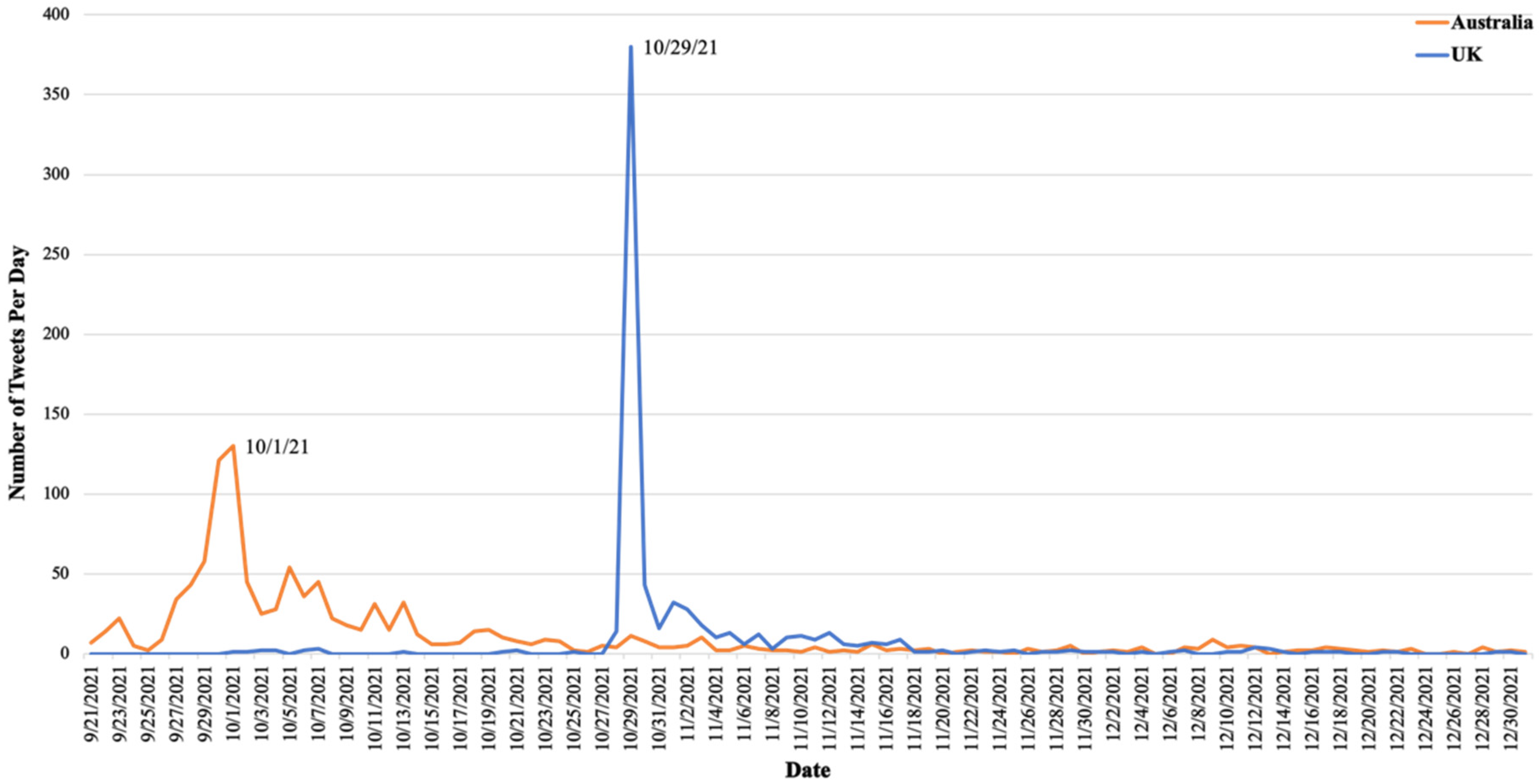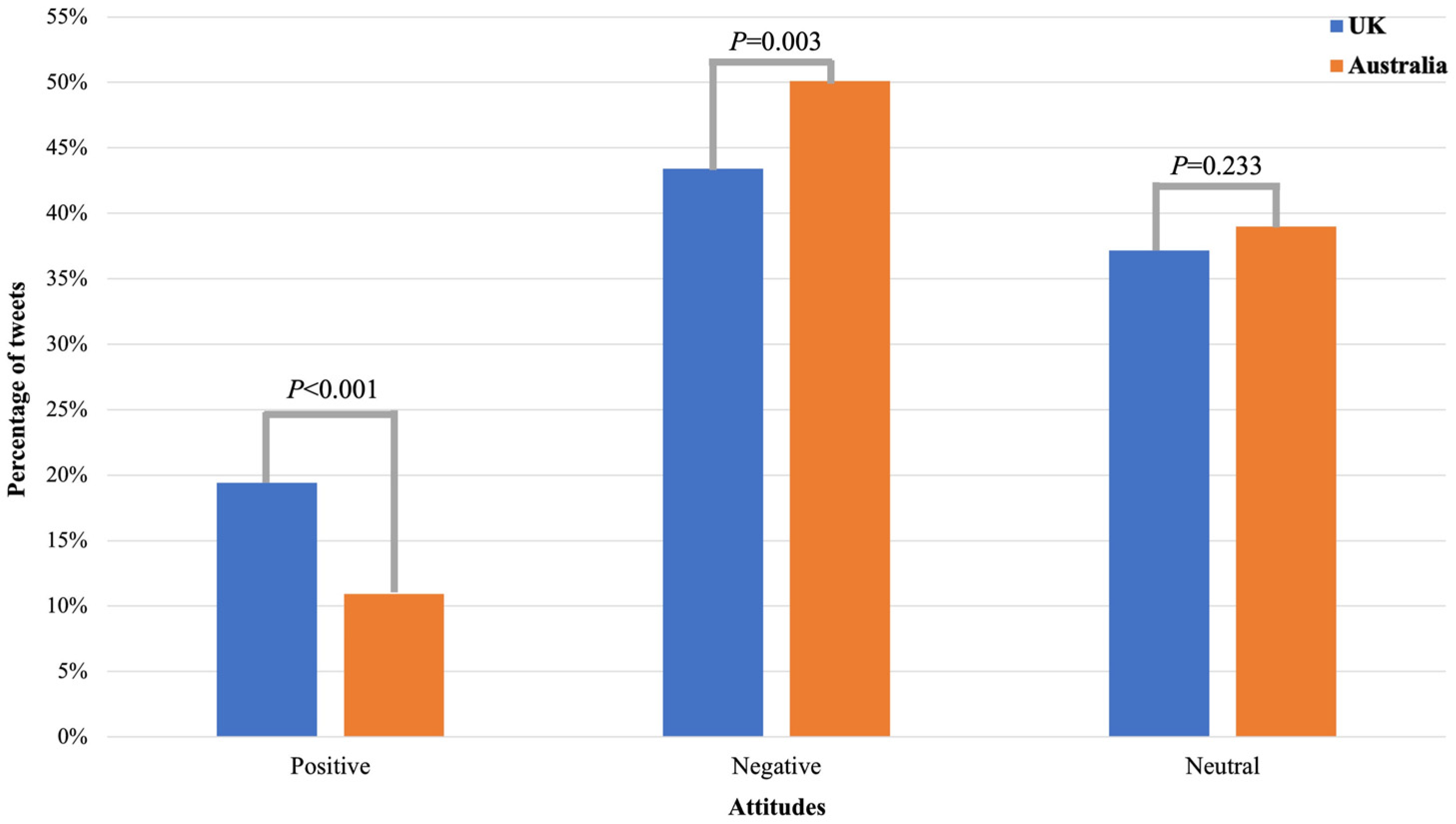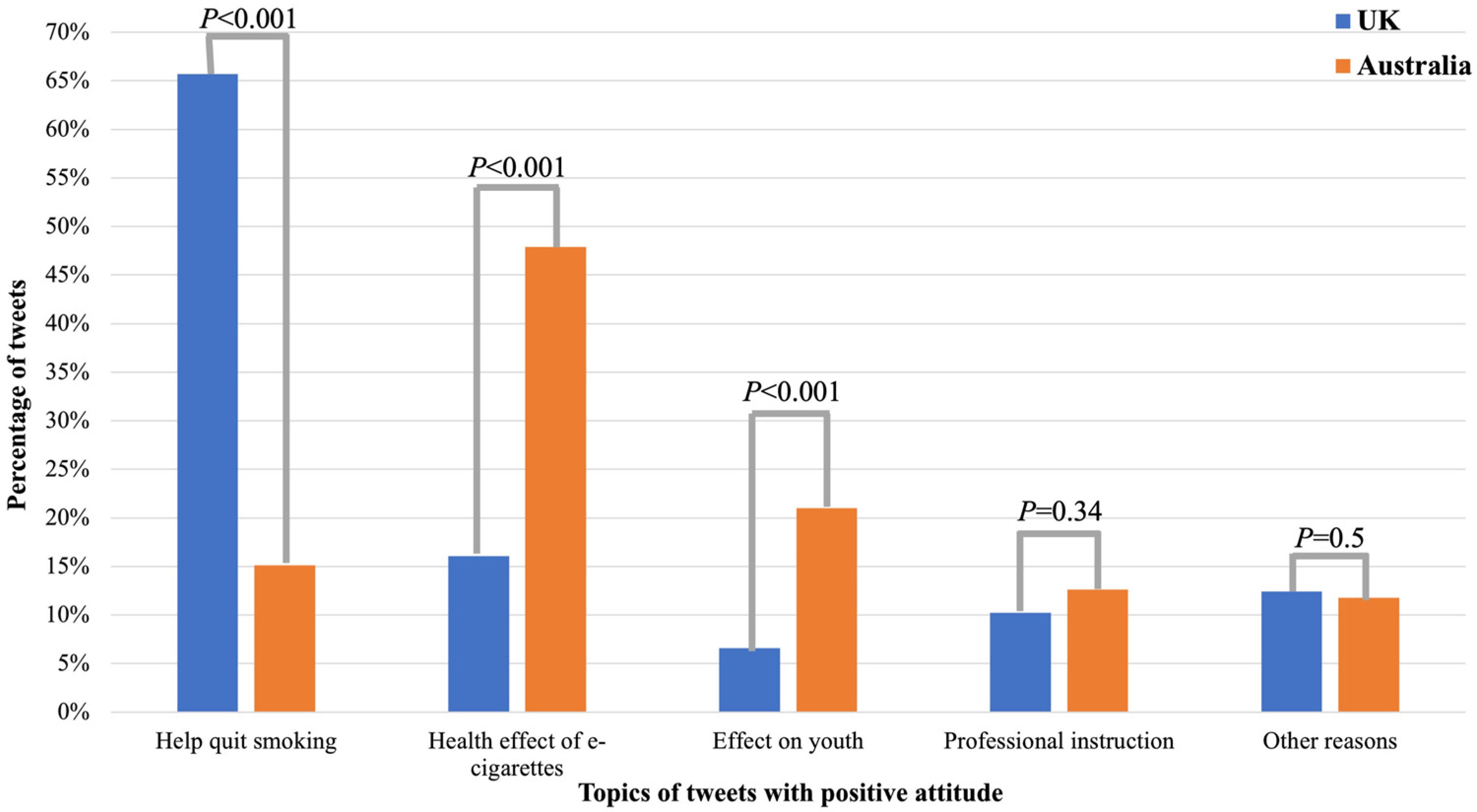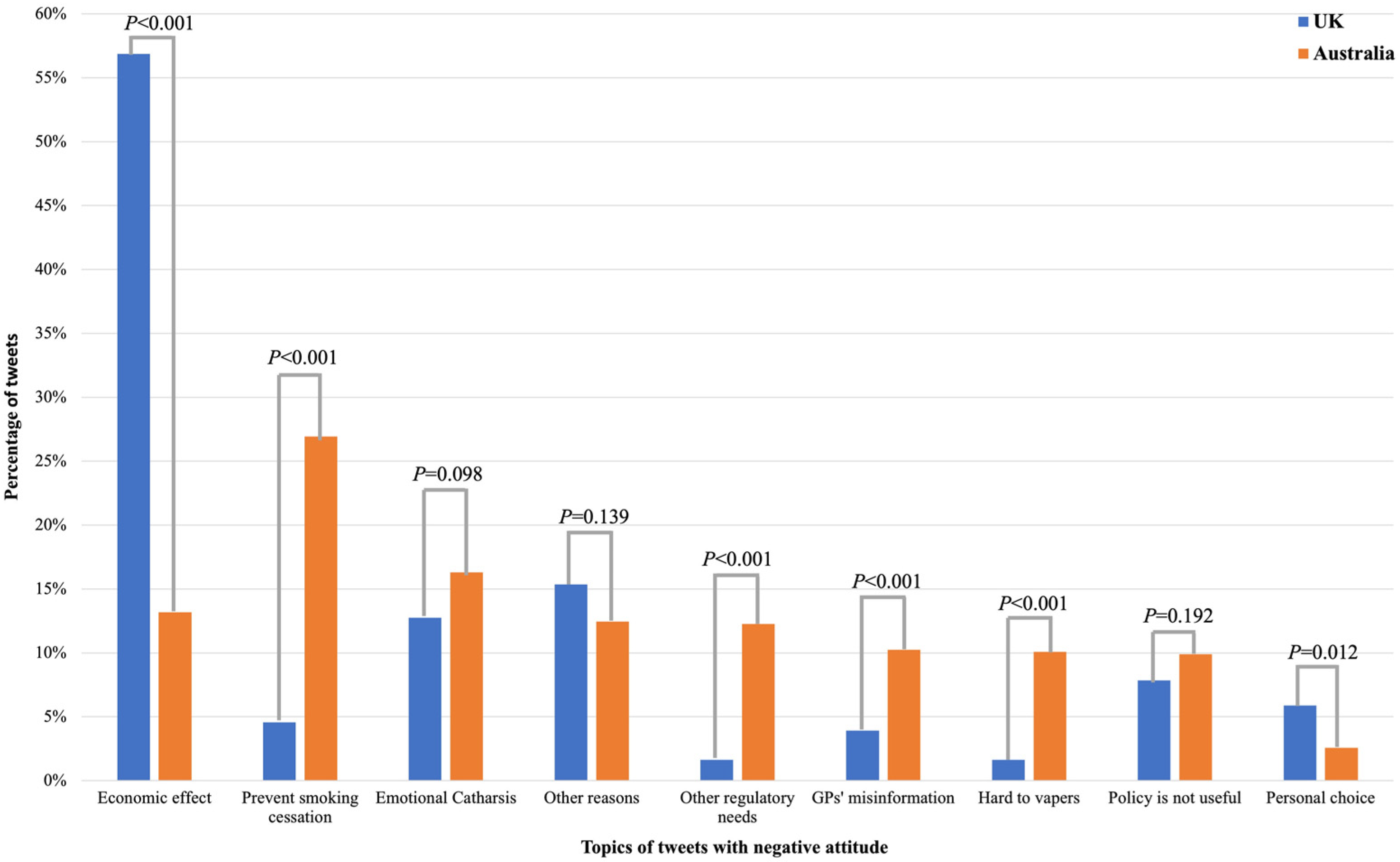Public Perceptions on the Policy of Electronic Cigarettes as Medical Products on Twitter
Abstract
:1. Introduction
2. Materials and Methods
2.1. Data Collection and Preprocessing
2.2. Content Analysis
2.3. Statistical Analysis
3. Results
3.1. Longitudinal Trend in the Mentions of the e-Cigarette Prescription Policy on Twitter in the UK and Australia
3.2. Attitudes towards the e-Cigarette Prescription Policy on Twitter in the UK and Australia
3.3. Topics in Tweets Mentioning the e-Cigarette Prescription Policy in the UK and Australia
4. Discussion
5. Conclusions
Supplementary Materials
Author Contributions
Funding
Institutional Review Board Statement
Informed Consent Statement
Data Availability Statement
Conflicts of Interest
References
- 6.2 Million Middle and High School Students Used Tobacco Products in 2019. Available online: https://www.cdc.gov/media/releases/2019/1205-nyts-2019.html (accessed on 20 June 2022).
- Youth E-Cigarette Use Remains Serious Public Health Concern Amid COVID-19 Pandemic. Available online: https://www.cdc.gov/media/releases/2021/p0930-e-cigarette.html (accessed on 10 May 2022).
- Ann McNeill, L.B.; Robert, C.; Erikas, S.; Debbie, R. Vaping in England: 2021 Evidence Update Summary. Available online: https://www.gov.uk/government/publications/vaping-in-england-evidence-update-february-2021/vaping-in-england-2021-evidence-update-summary (accessed on 1 December 2022).
- Use of e-Cigarettes among Young People in Great Britain. Available online: https://ash.org.uk/resources/view/use-of-e-cigarettes-among-young-people-in-great-britain (accessed on 8 October 2022).
- Vaping and Young People for Educators. Available online: https://lungfoundation.com.au/resources/vaping-and-young-people-for-educators/ (accessed on 11 July 2022).
- THE FACTS on e-Cigarette Use among Youth and Young Adults. Available online: https://e-cigarettes.surgeongeneral.gov/ (accessed on 8 June 2022).
- Mental Health & Vaping. Available online: https://www.changetochill.org/mental-health-vaping/ (accessed on 10 July 2022).
- Qasim, H.; Karim, Z.A.; Rivera, J.O.; Khasawneh, F.T.; Alshbool, F.Z. Impact of Electronic Cigarettes on the Cardiovascular System. J. Am. Heart Assoc. 2017, 6, e006353. [Google Scholar] [CrossRef] [PubMed]
- Krishnasamy, V.P.; Hallowell, B.D.; Ko, J.Y.; Board, A.; Hartnett, K.P.; Salvatore, P.P.; Danielson, M.; Kite-Powell, A.; Twentyman, E.; Kim, L.; et al. Update: Characteristics of a Nationwide Outbreak of E-cigarette, or Vaping, Product Use Associated Lung Injury—United States, August 2019–January 2020. MMWR Morb. Mortal. Wkly Rep. 2020, 69, 90–94. [Google Scholar] [CrossRef] [PubMed]
- Department of Health and Aged Care, A.G. Nicotine Vaping Products: Information for Prescribers. Available online: https://www.tga.gov.au/nicotine-vaping-products-information-prescribers (accessed on 13 May 2022).
- Kent, C. England Could Begin to Prescribe e-Cigarettes as Medical Products. Available online: https://www.medicaldevice-network.com/analysis/is-an-e-cigarette-a-medical-device/ (accessed on 15 May 2022).
- Medicines and Healthcare Products Regulatory Agency. Guidance for licensing electronic cigarettes and other inhaled nicotine-containing products as medicines. Available online: https://www.gov.uk/guidance/licensing-procedure-for-electronic-cigarettes-as-medicines (accessed on 5 November 2022).
- Turner, A. How Many Users Does Twitter Have? 2023. Available online: https://www.bankmycell.com/blog/how-many-users-does-twitter-have#1 (accessed on 23 January 2023).
- Gao, Y.; Xie, Z.; Li, D. Investigating the Impact of the New York State Flavor Ban on e-Cigarette-Related Discussions on Twitter: Observational Study. JMIR Public Health Surveill. 2022, 8, e34114. [Google Scholar] [CrossRef] [PubMed]
- Lu, X.; Sun, L.; Xie, Z.; Li, D. Perception of the Food and Drug Administration Electronic Cigarette Flavor Enforcement Policy on Twitter: Observational Study. JMIR Public Health Surveill. 2022, 8, e25697. [Google Scholar] [CrossRef] [PubMed]
- Sun, L.; Lu, X.; Xie, Z.; Li, D. Public Reactions to the New York State Policy on Flavored Electronic Cigarettes on Twitter: Observational Study. JMIR Public Health Surveill. 2022, 8, e25216. [Google Scholar] [CrossRef] [PubMed]
- Lu, X.; Chen, L.; Yuan, J.; Luo, J.; Luo, J.; Xie, Z.; Li, D. User Perceptions of Different Electronic Cigarette Flavors on Social Media: Observational Study. J. Med. Internet. Res. 2020, 22, e17280. [Google Scholar] [CrossRef] [PubMed]
- Baziotis, C.; Pelekis, N.; Doulkeridis, C. DataStories at SemEval-2017 Task 4: Deep LSTM with Attention for Message-level and Topic-based Sentiment Analysis. In Proceedings of the 11th International Workshop on Semantic Evaluation (SemEval-2017), Vancouver, BC, Canada, 3–4 August 2017. [Google Scholar]
- Conneau, A.; Khandelwal, K.; Goyal, N.; Chaudhary, V.; Wenzek, G.; Guzmán, F.; Grave, E.; Ott, M.; Zettlemoyer, L.; Stoyanov, V. Unsupervised Cross-lingual Representation Learning at Scale; Cornell University: Ithaca, NY, USA, 2019. [Google Scholar]
- Lazard, A.J.; Wilcox, G.B.; Tuttle, H.M.; Glowacki, E.M.; Pikowski, J. Public Reactions to e-Cigarette Regulations on Twitter: A Text Mining Analysis. Tob. Control. 2017, 26, e112–e116. [Google Scholar] [CrossRef] [PubMed]
- McCausland, K.; Maycock, B.; Leaver, T.; Wolf, K.; Freeman, B.; Jancey, J. E-Cigarette Advocates on Twitter: Content Analysis of Vaping-Related Tweets. JMIR Public Health Surveill. 2020, 6, e17543. [Google Scholar] [CrossRef] [PubMed]
- Department of Health and Aged Care, A.G. Nicotine Vaping Products: Information for Consumers. Available online: https://www.tga.gov.au/nicotine-vaping-products-information-consumers (accessed on 12 May 2022).
- Select Committee on Tobacco Harm Reduction. Available online: https://www.aph.gov.au/Parliamentary_Business/Committees/Senate/Tobacco_Harm_Reduction/TobaccoHarmReduction/Report (accessed on 5 December 2022).
- Australian Government Department of Health and Aged Care. Nicotine Vaping Products: Frequently Asked Questions. Available online: https://www.tga.gov.au/resources/resource/guidance/nicotine-vaping-products-frequently-asked-questions (accessed on 1 October 2022).
- Hill, C. Teens at Risk from a Lack of Education and Research on Vaping. Available online: https://news.griffith.edu.au/2022/04/08/teens-at-risk-from-a-lack-of-education-and-research-on-vaping/ (accessed on 3 December 2022).
- Country Laws Regulating E-Cigarettes. Available online: https://www.globaltobaccocontrol.org/en/policy-scan/e-cigarettes (accessed on 12 September 2022).
- VAT Rates. Available online: https://www.gov.uk/vat-rates (accessed on 15 September 2022).
- Caponnetto, P.; Saitta, D.; Sweanor, D.; Polosa, R. What to consider when regulating electronic cigarettes: Pros, cons and unintended consequences. Int. J. Drug Policy 2015, 26, 554–559. [Google Scholar] [CrossRef] [PubMed]
- Mendelsohn, C.P.; Wodak, A. Which Regulatory Framework Is Best for Nicotine Vaping? Am. J. Public Health 2022, 112, 1001–1002. [Google Scholar] [CrossRef] [PubMed]
- Hall, W.; Gartner, C.; Forlini, C. Ethical issues raised by a ban on the sale of electronic nicotine devices. Addiction 2015, 110, 1061–1067. [Google Scholar] [CrossRef] [PubMed]
- Niemietz, K. Wizards of Oz? What the UK Can Learn from Australia’s Healthcare System. Available online: https://iea.org.uk/publications/wizards-of-oz-what-the-uk-can-learn-from-australias-healthcare-system/ (accessed on 23 January 2023).
- Gibson, J.E.; Murray, R.L.; Borland, R.; Cummings, K.M.; Fong, G.T.; Hammond, D.; McNeill, A. The impact of the United Kingdom’s national smoking cessation strategy on quit attempts and use of cessation services: Findings from the International Tobacco Control Four Country Survey. Nicotine Tob. Res. 2010, 12 (Suppl. S1), S64–S71. [Google Scholar] [CrossRef] [PubMed]
- Bascombe, T.M.; Scott, K.N.; Ballard, D.; Smith, S.A.; Thompson, W.; Berg, C.J. Primary healthcare provider knowledge, beliefs and clinic-based practices regarding alternative tobacco products and marijuana: A qualitative study. Health Educ. Res. 2016, 31, 375–383. [Google Scholar] [CrossRef] [PubMed]
- Kanchustambham, V.; Saladi, S.; Rodrigues, J.; Fernandes, H.; Patolia, S.; Santosh, S. The knowledge, concerns and healthcare practices among physicians regarding electronic cigarettes. J. Community Hosp. Intern. Med. Perspect. 2017, 7, 144–150. [Google Scholar] [CrossRef] [PubMed]
- Nickels, A.S.; Warner, D.O.; Jenkins, S.M.; Tilburt, J.; Hays, J.T. Beliefs, Practices, and Self-efficacy of US Physicians Regarding Smoking Cessation and Electronic Cigarettes: A National Survey. Nicotine Tob. Res. 2017, 19, 197–207. [Google Scholar] [CrossRef] [PubMed]




Disclaimer/Publisher’s Note: The statements, opinions and data contained in all publications are solely those of the individual author(s) and contributor(s) and not of MDPI and/or the editor(s). MDPI and/or the editor(s) disclaim responsibility for any injury to people or property resulting from any ideas, methods, instructions or products referred to in the content. |
© 2023 by the authors. Licensee MDPI, Basel, Switzerland. This article is an open access article distributed under the terms and conditions of the Creative Commons Attribution (CC BY) license (https://creativecommons.org/licenses/by/4.0/).
Share and Cite
Lou, X.; Liu, P.; Xie, Z.; Li, D. Public Perceptions on the Policy of Electronic Cigarettes as Medical Products on Twitter. Int. J. Environ. Res. Public Health 2023, 20, 2618. https://doi.org/10.3390/ijerph20032618
Lou X, Liu P, Xie Z, Li D. Public Perceptions on the Policy of Electronic Cigarettes as Medical Products on Twitter. International Journal of Environmental Research and Public Health. 2023; 20(3):2618. https://doi.org/10.3390/ijerph20032618
Chicago/Turabian StyleLou, Xubin, Pinxin Liu, Zidian Xie, and Dongmei Li. 2023. "Public Perceptions on the Policy of Electronic Cigarettes as Medical Products on Twitter" International Journal of Environmental Research and Public Health 20, no. 3: 2618. https://doi.org/10.3390/ijerph20032618
APA StyleLou, X., Liu, P., Xie, Z., & Li, D. (2023). Public Perceptions on the Policy of Electronic Cigarettes as Medical Products on Twitter. International Journal of Environmental Research and Public Health, 20(3), 2618. https://doi.org/10.3390/ijerph20032618







